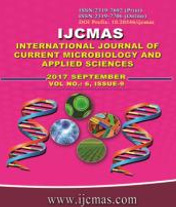


 National Academy of Agricultural Sciences (NAAS)
National Academy of Agricultural Sciences (NAAS)

|
PRINT ISSN : 2319-7692
Online ISSN : 2319-7706 Issues : 12 per year Publisher : Excellent Publishers Email : editorijcmas@gmail.com / submit@ijcmas.com Editor-in-chief: Dr.M.Prakash Index Copernicus ICV 2018: 95.39 NAAS RATING 2020: 5.38 |
Nigella (Nigella sativa L.) has been widely acknowledged for its immense medicinal properties in different medicinal systems. Recognizing the importance of the crop as a potential component in crop diversification in Coastal Humid Tropic of India, a systematic study on the effect of date of sowing and plant densities on growth, yield and quality of nigella was under taken during winter growing season (rabi). The different dates of sowing had significant influence on growth and yield of nigella. Delay in sowing caused reduction in growth, phenology, yield and quality. The optimum sowing time in Coastal Humid Tropic of India was found to be between 1st fortnights of October to 1st fortnight of November, sowing beyond this period had undesirable effects on the crop. Plant densities had significant effect on plant growth and quality of nigella. The individual growth parameters of the crop were lowest in the crop sown with 50 plants m-2. However, grain, fixed oil and essential oil yields were higher in the density of 50 plants m-2. Maximum seed yield (kg ha-1), stalk yield (g m-2), fixed oil yield (kg ha-1) and essential oil yield (L ha-1) were recorded in the first three dates of sowing (sowing window between 1st fortnight of October to 1st fortnight of November) at 50 plants m-2 density.
 |
 |
 |
 |
 |